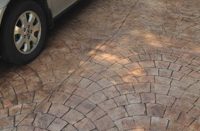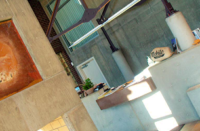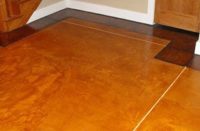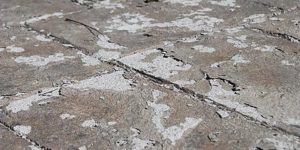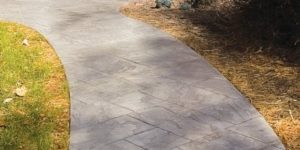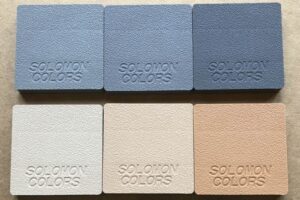As with most things in life, a decorative concrete installer faces many choices when it comes to the products and processes he or she uses on a job. Unfortunately, the choice is often made to take the path of least resistance or buy at low cost versus favoring long-term performance and the quality of the project.
However, when it comes to one type of decorative concrete product and one type of project, making an informed and educated choice results in a significant quality increase without a significant increase in time or money. That product is color hardener, and the market is small to medium-sized stamped concrete projects.
When it comes to stamping small to medium-sized concrete pours, the benefits of using color hardener compared to integral color can be summed up in two words – color and hardness.
By using color hardener the applicator controls the color. The issues of varying cement colors and slump affecting color consistency pretty much go away. A great analogy I was taught years ago that I still use today compares color in concrete to a cup of coffee. Integral color in concrete is like cream added to coffee – no matter how much you add, it will never turn the coffee white, just a lighter shade of brown. The base color will have a dramatic impact on the final color outcome. Color hardener is more like adding whipped cream to the top of the coffee, which completely takes base color out of play. Color hardener also offers a much broader color range, while integral color often requires white cement to achieve those same colors. Many of the leading stamped concrete installers I know prefer color hardener because it allows them to control the color application as well as blend multiple colors to achieve a more natural-looking end product.
More important, and often overlooked, is the second advantage – increased surface hardness and abrasion resistance. Color hardener is a blend of cement, sand, color and, in some cases, polymers that aid in wetting and finishing. When worked into the surface of the concrete, the cement and sand create a much stronger surface paste, typically increasing the surface strength by 1,000 psi to 2,000 psi when compared to standard concrete mixes. I have personal knowledge of many exterior stamped concrete slabs located in harsh freeze-thaw or high-traffic environments where color hardener is the primary reason they have outlasted their integral-color counterparts by years.
In fairness, I have to address the common negative comments associated with color hardener. The primary issue that is always near the top of the list is the cleanliness factor. Yes, color hardener can be messy. However, it does not have to be out-of-control messy. You, your crew and everything within 100 feet does not need to be covered in color. Using a brush or spreader or refining your throwing technique can make for a relatively clean job site. A little practice, and even novice applicators can take full advantage of the benefits color hardener can provide.
The other comment I often hear is that it’s just as easy to order concrete with color already in it. To that I say, yes it is, but what value do you put on the long-term quality of your work and setting yourself apart from you competition?
When you compare color hardener to integral color, the cost is pretty much a wash, yet the durability gained from using color hardener is proven science. Keep in mind that stamped concrete jobs are usually not lost or won because of the cost of color. They are, however, won and lost based on your resume and the longevity of your work.
In the interest of full disclosure, let me be clear that I am not against integral color. In fact, I have been marketing and selling integral pigments for 15 years. I am, however, a firm believer in selecting the right product for the job. There are many situations when using integral color is the best product choice. The key variables to consider when selecting your coloring method are job size, pouring logistics, color choice, environmental conditions, and texture selection. Understanding the products you use and the benefits associated with them is part of being a successful decorative concrete installer.
